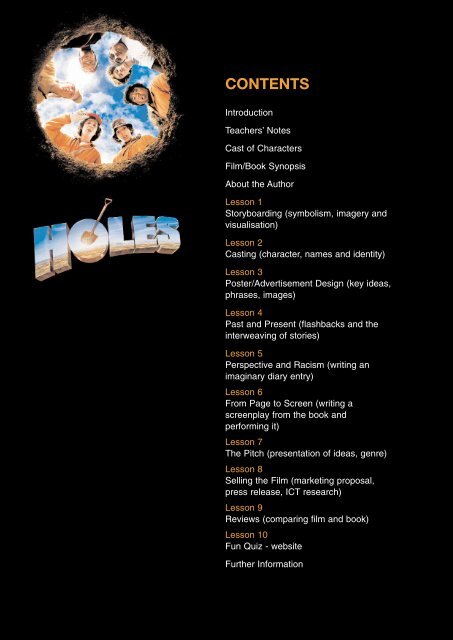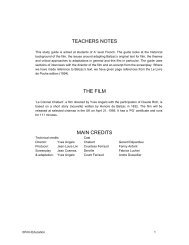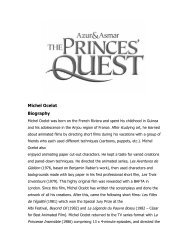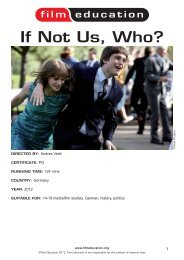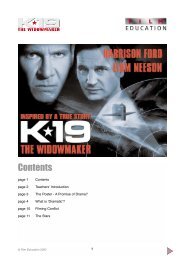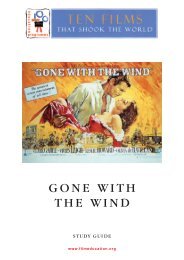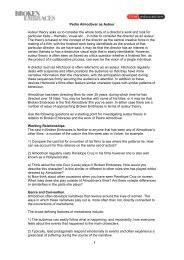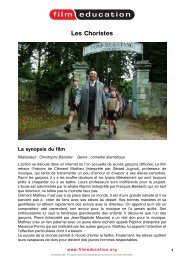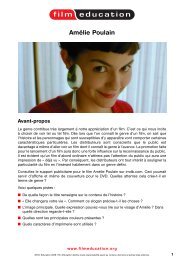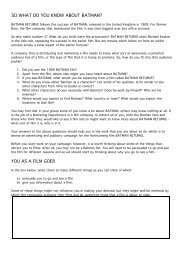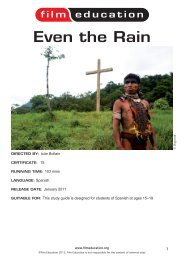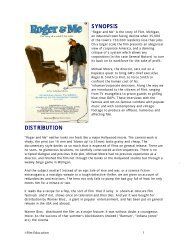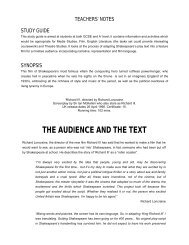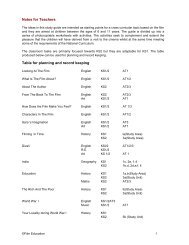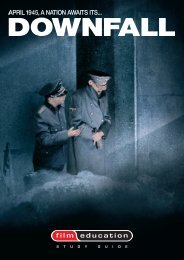Holes study guide - Film Education
Holes study guide - Film Education
Holes study guide - Film Education
Create successful ePaper yourself
Turn your PDF publications into a flip-book with our unique Google optimized e-Paper software.
CONTENTS<br />
Introduction<br />
Teachers’ Notes<br />
Cast of Characters<br />
<strong>Film</strong>/Book Synopsis<br />
About the Author<br />
Lesson 1<br />
Storyboarding (symbolism, imagery and<br />
visualisation)<br />
Lesson 2<br />
Casting (character, names and identity)<br />
Lesson 3<br />
Poster/Advertisement Design (key ideas,<br />
phrases, images)<br />
Lesson 4<br />
Past and Present (flashbacks and the<br />
interweaving of stories)<br />
Lesson 5<br />
Perspective and Racism (writing an<br />
imaginary diary entry)<br />
Lesson 6<br />
From Page to Screen (writing a<br />
screenplay from the book and<br />
performing it)<br />
Lesson 7<br />
The Pitch (presentation of ideas, genre)<br />
Lesson 8<br />
Selling the <strong>Film</strong> (marketing proposal,<br />
press release, ICT research)<br />
Lesson 9<br />
Reviews (comparing film and book)<br />
Lesson 10<br />
Fun Quiz - website<br />
Further Information
INTRODUCTION<br />
‘Camp Green Lake is a camp for bad boys. If you take a bad boy and make him dig a hole<br />
every day in the hot sun, it will turn him into a good boy. That was what some people<br />
thought.’ (p.5)<br />
<strong>Holes</strong> is the uplifting story of Stanley Yelnats (played by newcomer Shia LaBeouf), a boy<br />
dogged by family bad luck and innocent of the crime that has caused him to be sent to a<br />
juvenile correctional facility. Is it just bad luck? Or could it be fate?<br />
<strong>Holes</strong> has been adapted from the book by award-winning Louis Sachar (one of the BBC’s<br />
The Big Read Top 100), and has quickly taken its place amongst the classics of children’s<br />
fiction. Interweaving two stories from the past, brought together and resolved by Stanley in<br />
the present, <strong>Holes</strong> is a faithful and satisfying adaptation of a touching and funny book.<br />
This <strong>study</strong> <strong>guide</strong> is for teachers and students, and concentrates on the many layered<br />
themes of the story, looking at the film and book in conjunction, and considers the process<br />
of adaptation of one medium to another.<br />
pictured on right: Stanley Yelnats © 2003 Walden Media, LLC<br />
© <strong>Film</strong> <strong>Education</strong> 2003<br />
1
TEACHERS’ NOTES<br />
KS3 Framework references are listed below and are specifically Year 8 teaching objectives,<br />
but the tasks can be easily adapted to suit different year groups and abilities across the key<br />
stage. This digital resource is primarily for English/Media studies, although there are many<br />
elements that can be taught in other lessons (see Further Information, p. 21).<br />
The initial lessons assume that students will be reading the book alongside the set tasks:<br />
chapter coverage is indicated at the beginning of each ‘lesson’, where appropriate.<br />
Teachers are left to their own discretion with regard to structuring reading time to coincide<br />
with the tasks. By the end of lesson 6 the reading of <strong>Holes</strong> should be complete; for lesson<br />
9, students should have seen the film in advance.<br />
No time frame has been provided for lessons as tasks have been grouped by theme to<br />
accommodate differing lesson and reading times. Most tasks are designed to be group<br />
activities, but may be adapted.<br />
National Curriculum/Framework for Teaching English References<br />
Lesson 1: Storyboarding (symbolism, imagery and visualisation)<br />
Word: W9 Specialist vocabulary; W11 figurative language<br />
Reading: R5 trace the development of themes<br />
Writing: W8 develop an imaginative treatment; W10 organise and present information<br />
Speaking and Listening: SL11 recognise and build on other people’s contributions<br />
Lesson 2: Casting (character, names and identity)<br />
Sentence: S9 Adapt stylistic conventions<br />
Reading: R12 Independent reading; R5 Developing themes; R8 Meaning and media<br />
Writing: W8 Developing an imaginative treatment; W10 Organising and presenting<br />
information<br />
Speaking and Listening: L10 Using talk; S15 Drama in role; S4 Provide and explanation or<br />
commentary<br />
© <strong>Film</strong> <strong>Education</strong> 2003<br />
2
Lesson 3: Poster/Advertisement Design (key ideas, phrases, images)<br />
Word: W11 figurative language; W12 formality and word choice<br />
Sentence: S9 adapting a stylistic convention<br />
Reading: R1 combining information<br />
Writing: W7 experiment with different language choices; W10 organise and present<br />
information<br />
Speaking and Listening: SL10 use talk to question, hypothesise, speculate, evaluate, solve<br />
problems<br />
Lesson 4: Past and Present (flashbacks and the interweaving of stories)<br />
Reading: R14 recognise the conventions of some common literary forms<br />
Writing: W10 organise and present information<br />
This lesson also addresses aspects of numeracy<br />
Lesson 5: Perspective and Racism (writing an imaginary diary entry)<br />
Sentence: S1 combine clauses; S2 sentence structures; S3 punctuation; S4 tenses<br />
Reading: R6 recognise bias and objectivity; R15 texts and their times<br />
Writing: W2 re-read work and revise; W6 figurative language; W7 language choice<br />
Lesson 6: From Page to Screen (writing a screenplay from the book<br />
and performing it)<br />
Reading: R5 development of themes; R6 recognise bias and objectivity<br />
Writing: W8 imaginative treatment<br />
Speaking and Listening: D16 collaborate in, and evaluate, the presentation of dramatic<br />
performances<br />
Lesson 7: The Pitch (presentation of ideas, genre)<br />
Writing: W8 imaginative treatment; W10 organise and present information; W13 present a<br />
case persuasively<br />
Speaking and Listening: S3 formal presentation; S4 commentary; L6 own skills as<br />
listeners; G9 group talk<br />
© <strong>Film</strong> <strong>Education</strong> 2003<br />
3
Lesson 8: Selling the <strong>Film</strong> (marketing proposal, press release, ICT<br />
research)<br />
Sentence: S8 use of stylistic conventions; S9 adapting stylistic conventions<br />
Reading: R1 combine information; R2 independent research<br />
Writing: W5 commentary and description in narrative; W13 present a case persuasively<br />
Lesson 9: Reviews (comparing film and book)<br />
Sentence: S8 stylistic conventions<br />
Reading: R1 combine information; R3 make notes; R5 trace the development of themes;<br />
R6 recognise bias and objectivity; R8 how meanings change when presented in different<br />
forms<br />
Writing: R18 write a critical review<br />
Speaking and Listening: L7 listen for a specific purpose<br />
For all lessons<br />
Visit: www.filmeducation.org and www.holes.com<br />
© <strong>Film</strong> <strong>Education</strong> 2003<br />
4
CAST OF CHARACTERS<br />
The Warden........................................Sigourney Weaver<br />
Mr Sir..................................................Jon Voight<br />
Dr Pendanski......................................Tim Blake Nelson<br />
Stanley (Caveman).............................Shia LaBeouf<br />
Zero (Hector)......................................Khleo Thomas<br />
Squid (Alan)....................................... Jake M Smith<br />
Armpit (Theodore).............................. Byron Cotton<br />
X-Ray (Rex)....................................... Brenden Jefferson<br />
Magnet (Jose).................................... Miguel Castro<br />
Zigzag (Ricky).................................... Max Kasch<br />
Stanley’s Mother.................................Siobhan Fallon Hogan<br />
Stanley’s Father..................................Henry Winkler<br />
Clyde ‘Sweetfeet’ Livingston.............. Rick Fox<br />
Madame Zeroni.................................. Eartha Kitt<br />
Elya Yelnats........................................Damien Luvara<br />
Kissin’ Kate Barlow.............................Patricia Arquette<br />
Sam.................................................... Dulé Hill<br />
Trout Walker....................................... Scott Plank<br />
pictured on left: Mr Sir, The Warden, Dr Pendanski; right: The Camp Green Lake Gang © 2003 Walden Media, LLC<br />
© <strong>Film</strong> <strong>Education</strong> 2003<br />
5
FILM/BOOK SYNOPSIS<br />
Stanley, an unlucky and bullied boy, is sent to a juvenile correctional facility at Camp Green<br />
Lake, deep in the Texas desert, when he is convicted of stealing a pair of sneakers<br />
belonging to Clyde ‘Sweetfeet’ Livingston. On arrival he realises that this is no ordinary<br />
‘camp’: here the boys must dig one hole per day, five feet across and five feet down in the<br />
blistering heat, with little water. The other boys, with their strange nicknames, are not<br />
initially friendly, but he becomes a part of their group, forming a special friendship with the<br />
quiet Zero.<br />
Stanley soon begins to wonder exactly why they are digging the holes in the bed of the<br />
dried-up lake – especially as the Warden is uncommonly interested in anything that they<br />
find. Does it have anything to do with the outlaw Kissin’ Kate Barlow, who robbed Stanley’s<br />
great-grandfather one hundred years ago? Can he escape from his inherited bad luck?<br />
After Zero runs away, Stanley must rescue his friend, solve the mystery and break the<br />
curse, once and for all.<br />
Locations:<br />
Early C19th, Latvia<br />
Late C19th, Green Lake, Texas<br />
Present day, Camp Green Lake<br />
pictured on left and right: Stanley and Zero © 2003 Walden Media, LLC<br />
© <strong>Film</strong> <strong>Education</strong> 2003<br />
6
ABOUT THE AUTHOR<br />
Louis Sachar, author and screenwriter of the film and book, was born in New York in 1954.<br />
As a full-time writer, Louis’s work-day routine includes shutting himself away in his <strong>study</strong><br />
where he writes for two hours daily, with his dogs for company. Louis says that ‘...writing is<br />
a kind of self-hypnosis...’ (from www.kidsreads.com): he writes and re-writes his novels,<br />
and does not talk about his work in progress, even to his wife and daughter. He had his first<br />
children’s book published, ‘Sideways Stories from Wayside School’ whilst he was still at<br />
college. After graduating as a lawyer, he continued to write fiction and eventually gave up<br />
practicing law to concentrate on his writing. He began writing the ‘Marvin Redpost’ series<br />
when his daughter was four, which is why Marvin has a four-year-old sister.<br />
Louis wrote the screenplay for the film, as the director (Andrew Davis) was keen to make<br />
a faithful rendition of the book, and capture the special mix of comedy, mystery and sense<br />
of purpose that Louis conveys in <strong>Holes</strong>. He says that he had a wonderful experience<br />
making the film, and got to see the process from the beginning. He was most impressed<br />
with the amount of hard work that goes into film production:<br />
‘All you ever hear about movies is the glamour, hype, and stardom, but what I never<br />
realised is how hard everybody works. A lot of the movie was filmed in 100-degree heat.<br />
And members of the production company dug 450 holes in the Mojave Desert in California.’<br />
(p. 13, ‘The <strong>Holes</strong> Story: A Conversation with Louis Sachar’ by Kate Davis, Read Magazine,<br />
Vol. 52, No. 9, December 20, 2002)<br />
Louis has a small part in the film: watch out for his appearance.<br />
pictured from left to right: Andrew Davis, Louis Sachar © 2003 Walden Media, LLC<br />
© <strong>Film</strong> <strong>Education</strong> 2003<br />
7
LESSON 1: STORYBOARDING<br />
Coverage: chs 1-7<br />
(symbolism, imagery and visualisation)<br />
Read these initial chapters of <strong>Holes</strong> and discuss the themes and imagery that become<br />
apparent in the first part of the book, for example how is Camp Green Lake described and<br />
why is this at odds with its name?<br />
Now read the following information about storyboarding and complete the task.<br />
Storyboarding<br />
Storyboarding is a process of visualising<br />
written text, with technical camera<br />
details added, to allow a director to<br />
convey his intentions on how he would<br />
like to film a particular scene. It looks<br />
rather like a comic-strip.<br />
Some of the technical information will<br />
refer to action, camera direction and<br />
lighting.<br />
Angles<br />
● straight-on angle<br />
● high angle (the camera looking down<br />
on its subject)<br />
● low angle (the camera looking up at<br />
its subject)<br />
Think about the affect that using these differently will have on the shot (will it emphasise the<br />
vulnerability of the subject if the camera is at a high angle looking down?)<br />
Level<br />
● level camera shot (where the horizon is horizontal)<br />
● tilting<br />
● panning<br />
© <strong>Film</strong> <strong>Education</strong> 2003<br />
What you can see What you can hear<br />
8<br />
STORYBOARD
Height of the Camera<br />
This will determine the perspective of the audience, so that if the point of view were that of<br />
a child, the camera’s height would be close to the ground.<br />
Camera Distance from Subject<br />
● extreme long shot (for framing landscapes)<br />
● long shot (the character is at a distance, their whole body is in view)<br />
● mid shot (the character is shown from the knees/waist up, or full body if sitting)<br />
● close-up (shows character’s head and shoulders, used to show character’s facial<br />
expression)<br />
● extreme close-up (shows part of the face, lips to eyes, to convey emotion)<br />
● over the shoulder shot (view taken from over the shoulder of character, to show what<br />
he/she is seeing)<br />
● point-of-view shot (from character’s pov)<br />
● two shot (shows two characters)<br />
task<br />
task<br />
Now that you are familiar with the storyboarding process, turn to chapter 10 of <strong>Holes</strong><br />
and storyboard the section beginning ‘As long as the sun wasn’t out yet’ (p.49<br />
Bloomsbury 2000) to ‘He’d found his miracle’ (p. 50). When you<br />
read each sentence try to capture what you see in your head;<br />
pick out the adjectives (descriptive words) and any<br />
descriptive sentences: think how you can show your<br />
imagination in pictures.<br />
Visit: www.filmeducation.org and www.holes.com<br />
© <strong>Film</strong> <strong>Education</strong> 2003<br />
9
Coverage: chs 8-17<br />
LESSON 2: CASTING<br />
(character, names and identity)<br />
Why are names so important in the story? All of the boys have unusual nicknames: X-Ray,<br />
Magnet, Armpit etc. Why do their nicknames suit each character? Why is it important that<br />
Stanley’s name is a palindrome (a word that is spelt the same backwards as it is forwards)?<br />
Do you think ‘Caveman’ is an appropriate name for Stanley?<br />
task<br />
task<br />
Link the actual name of the boy, his nickname and a personality trait that he possesses.<br />
Find textual evidence (quote page numbers) to support your reasons.<br />
Rex<br />
Zigzag<br />
© <strong>Film</strong> <strong>Education</strong> 2003<br />
Theodore<br />
steals things<br />
Magnet<br />
Jose<br />
Armpit<br />
Alan<br />
mean<br />
10<br />
Squid<br />
unpredictable<br />
Ricky<br />
Visit: www.filmeducation.org and www.holes.com<br />
smelly<br />
poor eyesight<br />
X-Ray
task<br />
task<br />
In groups, imagine that one of you is a character from <strong>Holes</strong>, the rest of the group will ask<br />
your character questions and you must answer in character. (Note to teachers: you may<br />
feel that you are best able to fill this role, perhaps taking the persona of one of the adults<br />
in the story, Mr Sir or Pendanski?)<br />
task<br />
task<br />
You are the casting agent for the production company that is to make <strong>Holes</strong> into a movie.<br />
Make suggestions for possible actors for each role, allowing for appearance, voice,<br />
demeanour and behaviour. Now write an advertisement for the role to be placed in an<br />
industry magazine.<br />
Visit: www.filmeducation.org and www.holes.com<br />
pictured on left: Mr Sir, right: The Camp Green Lake Gang © 2003 Walden Media, LLC<br />
© <strong>Film</strong> <strong>Education</strong> 2003<br />
11
task<br />
task<br />
LESSON 3:<br />
POSTER/ADVERTISEMENT DESIGN<br />
(key ideas, phrases, images)<br />
Design a poster for <strong>Holes</strong>: make a list of the key<br />
elements of the story (e.g. digging holes, buried<br />
treasure, an ancient family curse) and pick a striking<br />
image from the film. What do you want to convey to<br />
the audience? How will you entice people to come<br />
and see the movie? Think about the kind of language<br />
used in movie advertising.<br />
Things to include:<br />
● title<br />
● stars<br />
● tag-line<br />
● credits - the name of your production company<br />
(Walden Media and Buena Vista International (UK)<br />
Limited), website address etc.<br />
● release date<br />
Often the tag-line of the film is as important as the<br />
image on the poster, as its object is to condense the<br />
essence of the film in one memorable phrase (for<br />
example: Men in Black 2 - Same Planet; New Scum<br />
or Lord of the Rings, The Two Towers - A new power<br />
is rising). Make up your own tag-line, perhaps using<br />
a quote from the book.<br />
Visit: www.filmeducation.org and www.holes.com<br />
pictured on top and middle: Stanley and Zero; bottom: Stanley © 2003 Walden Media, LLC<br />
© <strong>Film</strong> <strong>Education</strong> 2003<br />
12
LESSON 4: PAST AND PRESENT<br />
(flashbacks and the interweaving of stories)<br />
Coverage: chs 18-28<br />
<strong>Holes</strong> has three stories interwoven: Elya Yelnats, Stanley’s no-good-dirty-rotten-pigstealing-great-great-grandfather,<br />
who is cursed by the gipsy; the story of Kissin’ Kate<br />
Barlow, a school teacher who became an outlaw; and Stanley’s imprisonment at Camp<br />
Green Lake. Why does the novel switch between the stories? What do you think are the<br />
connections between them? How do we know that the time and location have changed?<br />
In film, this convention is called flashback. Can you think of examples of films where this<br />
has been used? How did the director convey to the audience that the setting had changed?<br />
Was the lighting or mood different? Is the past filmed in black and white? What affect did it<br />
have on the film as a whole?<br />
task<br />
task<br />
Make a timeline of the three different<br />
storylines, plotting the events on a chart and<br />
making a note of where (and when) they cross<br />
over. Using flashback affects the order in<br />
which the story is told; why do you think Louis<br />
Sachar wrote <strong>Holes</strong> in this way?<br />
Visit: www.filmeducation.org and www.holes.com<br />
pictured: Stanley and Zero © 2003 Walden Media, LLC<br />
© <strong>Film</strong> <strong>Education</strong> 2003<br />
13
LESSON 5:<br />
PERSPECTIVE AND RACISM<br />
Coverage: chs 29-39<br />
(writing an imaginary diary entry)<br />
When asked how he creates believable<br />
characters, Louis Sachar replied:<br />
‘I put myself in their situation. I try to<br />
figure out what Stanley would be<br />
thinking. You always have to imagine<br />
what your character would be feeling and<br />
thinking, to see yourself as the<br />
character.’<br />
(p. 15, ‘The <strong>Holes</strong> Story: A Conversation with Louis Sachar’ by Kate Davis, Read<br />
Magazine, Vol. 52, No. 9, December 20, 2002)<br />
task<br />
task<br />
Read chapters 25 and 26 carefully. Imagine that you are Katherine Barlow and write a<br />
diary entry for her the day after she killed the sheriff, explaining her actions and<br />
describing her feelings. Think about her relationship with Sam and the townspeople’s<br />
reactions to it and the consequences for the town after Sam is killed.<br />
task<br />
task<br />
EXTENSION TASK:<br />
Imagine that you are a director and have been asked to ‘guest direct’ an additional<br />
scene that will be included on the DVD release. In the scene serene teacher Katherine<br />
Barlow (played by Patricia Arquette) transforms herself into outlaw Kissin’ Kate Barlow.<br />
Write down instructions for her to follow whilst she acts out the scene. How she should<br />
act – angry, upset, determined and why? What is her ‘motivation’? Remember to<br />
include how she should use props, like her new ‘outlaw’ clothes, during the scene .<br />
Would she treat them gently, as she would a silk dress?<br />
pictured: Mr Sir © 2003 Walden Media, LLC<br />
© <strong>Film</strong> <strong>Education</strong> 2003<br />
14
LESSON 6: FROM PAGE TO SCREEN<br />
(writing a screenplay from the book and performing it)<br />
Coverage: chs 40-50<br />
task<br />
task<br />
Pick a chapter from the book that you think is particularly dramatic. Turn the prose into<br />
a screenplay (this will include dialogue and direction). How will you convey what is<br />
going on without the presence of a narrator? How much dialogue does the scene<br />
need? Do you need to add more or change anything from the book? Remember to<br />
include any particular directional instructions such as camera angles and lighting<br />
(remembering the techniques you used for storyboarding). As you will be performing<br />
this scene, take into account any props you may need. Think of any instructions you<br />
would give an actor who is using your screenplay (what are the characters’ feelings at<br />
this moment in time?).<br />
task<br />
task<br />
Now perform your scene in front of another group. Discuss how you could have done<br />
it differently and whether or not you captured the meaning and emotional impact of the<br />
scene as it is described in the novel.<br />
Visit: www.filmeducation.org<br />
and www.holes.com<br />
pictured: Stanley © 2003 Walden Media, LLC<br />
© <strong>Film</strong> <strong>Education</strong> 2003<br />
15
task<br />
task<br />
LESSON 7: THE PITCH<br />
(presentation of ideas, genre)<br />
Now that you have finished reading <strong>Holes</strong> you should have<br />
a good idea of the type (or genre) of book that it is. How<br />
would you describe it? Is it an adventure story? A<br />
comedy? Or a mixture of several different genres? Think<br />
back to Lesson 3 when you designed a poster for the film<br />
version of the book; what were the key words you used to<br />
describe the story on the poster?<br />
The original title of the book was Wrong Time, Wrong<br />
Place, Wrong Kid. Why do you think it was renamed<br />
<strong>Holes</strong>? Is this a better title? Can you think of a better one?<br />
task<br />
task<br />
To get a movie made the writer or director will need the backing of a producer to<br />
provide the finances needed to put the project into production. Sometimes the<br />
producer is part of a studio: in the case of <strong>Holes</strong>, the studio that produced it was<br />
Disney. The initial meeting between the people with the idea for the film and the<br />
potential backers is called a ‘pitch’.<br />
Now imagine that you have the idea to turn <strong>Holes</strong> the book into <strong>Holes</strong> the film; you must<br />
now ‘sell’ your idea to the producer as concisely as you can. You do not have long, as<br />
the producer is a busy person and has many people to see. In pairs, come up with a<br />
short presentation (no longer than three minutes) in which you describe the essential<br />
elements of the book (the synopsis), why it is a story worth telling and who the audience<br />
might be. Remember that the film must have the potential to make money, and<br />
therefore must appeal to a large audience. (Note to teachers: it may be worth showing<br />
the clip from ‘The Player’ (1992: Dir. Robert Altman, Certificate 15) where the writer<br />
describes his script in terms of other films. Remember to point out that this is satire!)<br />
You could use your poster design and your storyboard as part of your presentation if<br />
you wish. Now present your pitch to the rest of the class. Afterwards discuss what<br />
makes a good pitch. Are the types of words used very memorable? Or, are the images<br />
more important?<br />
© <strong>Film</strong> <strong>Education</strong> 2003<br />
16
task<br />
task<br />
LESSON 8: SELLING THE FILM<br />
(marketing proposal, press release, ICT research)<br />
<strong>Holes</strong> the movie has been made: imagine that you are part of the post-production team<br />
that must sell the movie to the prospective audience.<br />
Think of the different ways in which you find out about a movie before it is released:<br />
television, the internet, poster campaigns, interviews in magazines etc. Now brainstorm<br />
all of the possible media outlets you will have to target to ensure as many people as<br />
possible know about your film. (Remember that the film came from a popular book, so<br />
you should publicise that as well, with a tie-in edition etc.)<br />
Its UK release date is scheduled for October 24, 2003. Why do you think this date was<br />
picked? What other films are being released around this time?<br />
(Visit www.launchingfilms.co.uk)<br />
task<br />
task<br />
Now consider who you will be targeting in your publicity campaign: who is your target<br />
audience? Why? How will you reach this audience through the media?<br />
For this task you will need internet access. Online, research all the different kinds of<br />
advertising you can find relating to the film/book of <strong>Holes</strong> (visit www.holes.com). Can<br />
you think of something that does not appear to have been done?<br />
task<br />
task<br />
EXTENSION TASK:<br />
Often the first, or most memorable time we hear about a film is through a trailer. Design<br />
a trailer for <strong>Holes</strong>, detailing which scenes from the film you would use and why; write<br />
the script for a voice-over and describe the kind of music you would use (if any).<br />
Remember to include all the information that the audience will need and will encourage<br />
them to see the film. A trailer is a taster of a movie, so you should not reveal too many<br />
things about the plot; tease your audience by giving them small pieces of information<br />
and make them want to find out more.<br />
Visit: www.filmeducation.org and www.holes.com<br />
© <strong>Film</strong> <strong>Education</strong> 2003<br />
17
Coverage: Book and film<br />
task<br />
task<br />
LESSON 9: REVIEWS<br />
(comparing film and book)<br />
Now watch the film. Make notes on anything that is different from the book. Is it better<br />
or worse? Why? Did the film live up to your expectations?<br />
Write a review for your school newspaper, comparing the two. Point out the differences<br />
between them and evaluate the success the film had in bringing the issues and themes<br />
of the book to light. Did the actors do justice to Sachar’s characters? Were there any<br />
scenes in the film that you thought were particularly well done? Did the film adaptation<br />
make you consider the book any differently? Finally, give the film a star rating.<br />
Visit: www.filmeducation.org and www.holes.com<br />
© <strong>Film</strong> <strong>Education</strong> 2003<br />
18
LESSON 10: FUN QUIZ<br />
For the interactive quiz to test your knowledge of <strong>Holes</strong> click here on the link to:<br />
© <strong>Film</strong> <strong>Education</strong> 2003<br />
www.filmeducation.org<br />
19
Cross Curricular Topics<br />
PSE<br />
FURTHER INFORMATION<br />
There are many issues in <strong>Holes</strong> that can be discussed in PSE lessons:<br />
● punishment and juvenile delinquency<br />
● illiteracy<br />
● racism<br />
● bullying<br />
● homelessness<br />
www.channel4.com/learning has good resources for PSE lessons, especially for lawrelated<br />
subjects.<br />
History<br />
In History lessons, <strong>Holes</strong> could be used as a springboard for exploring aspects of slavery<br />
and the Wild West.<br />
www.espresso.co.uk<br />
www.civilrightsmuseum.org<br />
http://memory.loc.gov/ammem/award97/codhtml/hawphome.html<br />
Geography<br />
<strong>Holes</strong> is set in the arid Texas desert. Check out the following websites for more information:<br />
www.netstate.com/states/intro/tx_intro.htm<br />
www.texas.gov<br />
Science<br />
For information about desert life try:<br />
www.cdri.org<br />
www.brainpop.com/science/ecology/desert/index.weml<br />
www.eduscapes.com/nature/lizard/<br />
www.ub.ntnu.no/scorpion-files/<br />
www.42explore.com/snake2.htm<br />
© <strong>Film</strong> <strong>Education</strong> 2003<br />
20
Information on onions can be found at:<br />
www.magicvalleygrowers.com/history.html<br />
www.sunspiced.com/ohistory.html<br />
Information on inventions:<br />
www.howthingswork.com<br />
www.greatachievements.org/<br />
ICT and Media<br />
www.holes.com<br />
www.walden.com<br />
www.kidsreads.com<br />
www.filmeducation.org<br />
Related <strong>Holes</strong> Publications<br />
‘<strong>Holes</strong>: The Official Movie Scrapbook’, Kovacs and LeMaire, (New York: Barnes and Noble<br />
Books, 2003)<br />
© <strong>Film</strong> <strong>Education</strong> 2003<br />
21


